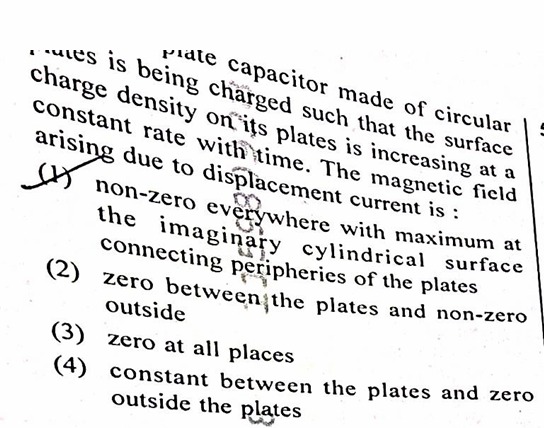Question
Question: Plates capacitor made of circular utes is being charged such that the surface charge density on its ...
Plates capacitor made of circular utes is being charged such that the surface charge density on its plates is increasing at a constant rate with time. The magnetic field arising due to displacement current is :

non-zero everywhere with maximum at the imaginary cylindrical surface connecting peripheries of the plates
zero between the plates and non-zero outside
zero at all places
constant between the plates and zero outside the plates
non-zero everywhere with maximum at the imaginary cylindrical surface connecting peripheries of the plates
Solution
The charging parallel plate capacitor has a uniform displacement current density Jd between the plates, directed from the positive plate to the negative plate. For circular plates of radius R, the displacement current density is Jd=ϵ0∂t∂E. Since the surface charge density is increasing at a constant rate, dtdσ is constant. The electric field between the plates is E=σ/ϵ0, so ∂t∂E=ϵ01dtdσ, which is constant and uniform between the plates. Thus, Jd is constant and uniform between the plates.
The magnetic field arising due to this displacement current can be found using Ampere-Maxwell's law: ∮B⋅dl=μ0Id,enc, where Id,enc is the displacement current enclosed by the Amperian loop. Due to the symmetry of the uniform displacement current flowing axially between the circular plates, the magnetic field lines are concentric circles in planes parallel to the plates, centered on the axis of the capacitor. The magnitude of the magnetic field B depends on the distance r from the axis.
Consider a circular Amperian loop of radius r centered on the axis, in a plane between the plates.
-
For r<R (inside the plates): The enclosed displacement current is Id,enc=Jd⋅(πr2). Applying Ampere-Maxwell's law: B(r)⋅(2πr)=μ0Jd(πr2). B(r)=2μ0Jdr. The magnetic field increases linearly with r from B=0 at r=0 to B=2μ0JdR at r=R.
-
For r>R (outside the plates): The enclosed displacement current is the total displacement current flowing between the plates, Id=Jd⋅(πR2). Applying Ampere-Maxwell's law: B(r)⋅(2πr)=μ0Id=μ0Jd(πR2). B(r)=2rμ0JdR2. The magnetic field decreases with r as 1/r for r>R.
Comparing the expressions for B(r), we see that for r≤R, the maximum value of B(r) is at r=R, with B(R)=2μ0JdR. For r>R, B(r) decreases from this value. Thus, the magnitude of the magnetic field is maximum at r=R, which corresponds to the cylindrical surface connecting the peripheries of the plates.
The magnetic field is non-zero everywhere except on the axis (r=0). Option (1) states "non-zero everywhere with maximum at the imaginary cylindrical surface connecting peripheries of the plates". While strictly speaking the field is zero on the axis, compared to the other options, this is the most accurate description. Option (2) is incorrect because the field is non-zero between the plates (for r>0). Option (3) is incorrect because displacement current creates a magnetic field. Option (4) is incorrect because the field between the plates is not constant, it varies with r.
Therefore, the magnetic field arising due to displacement current is non-zero everywhere (except the axis) and has its maximum magnitude at the cylindrical surface connecting the peripheries of the plates.
